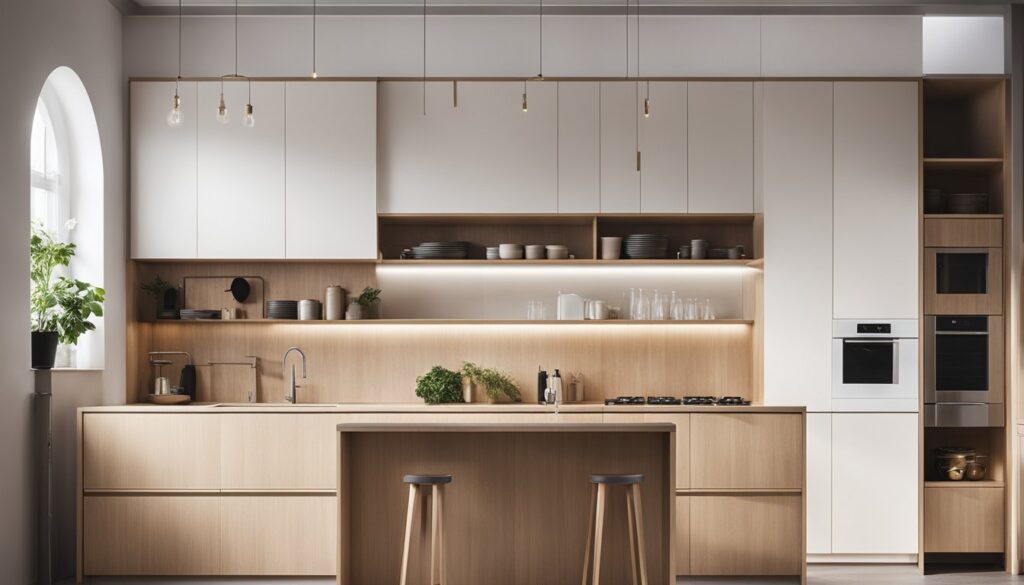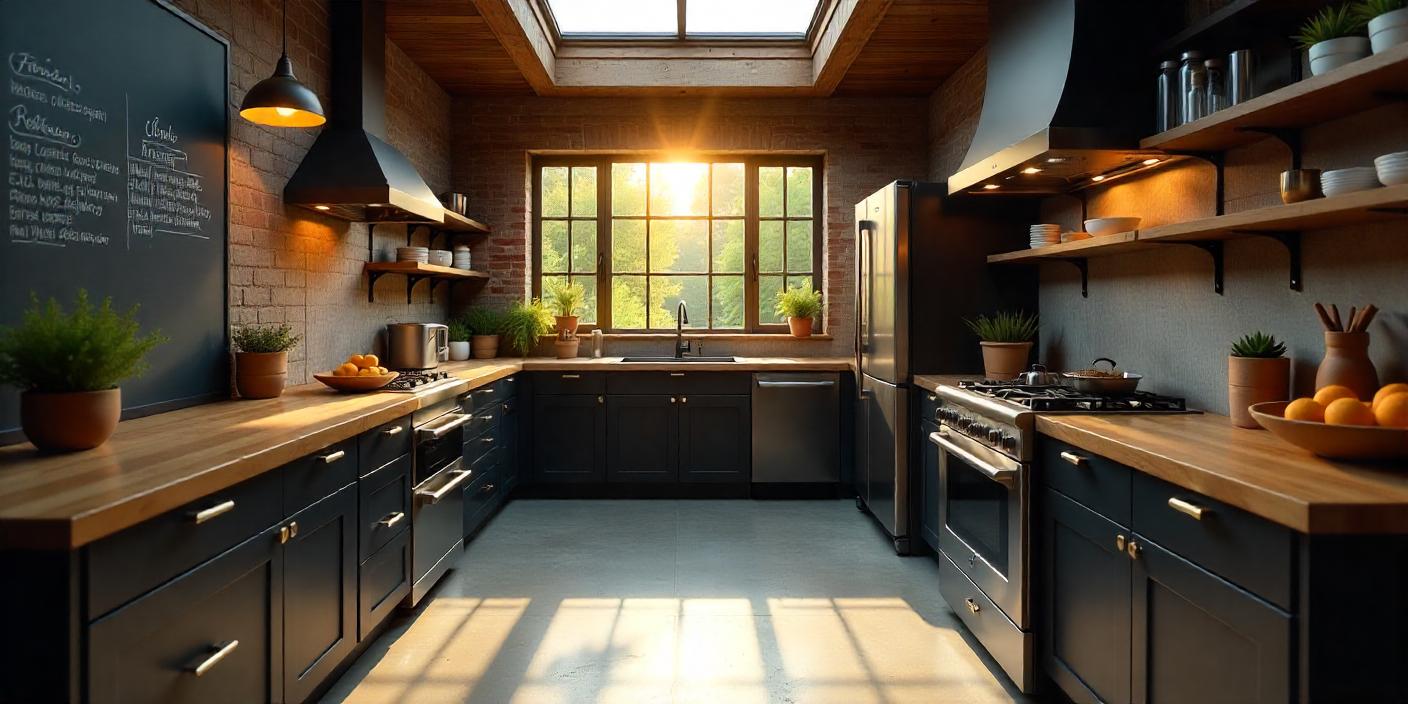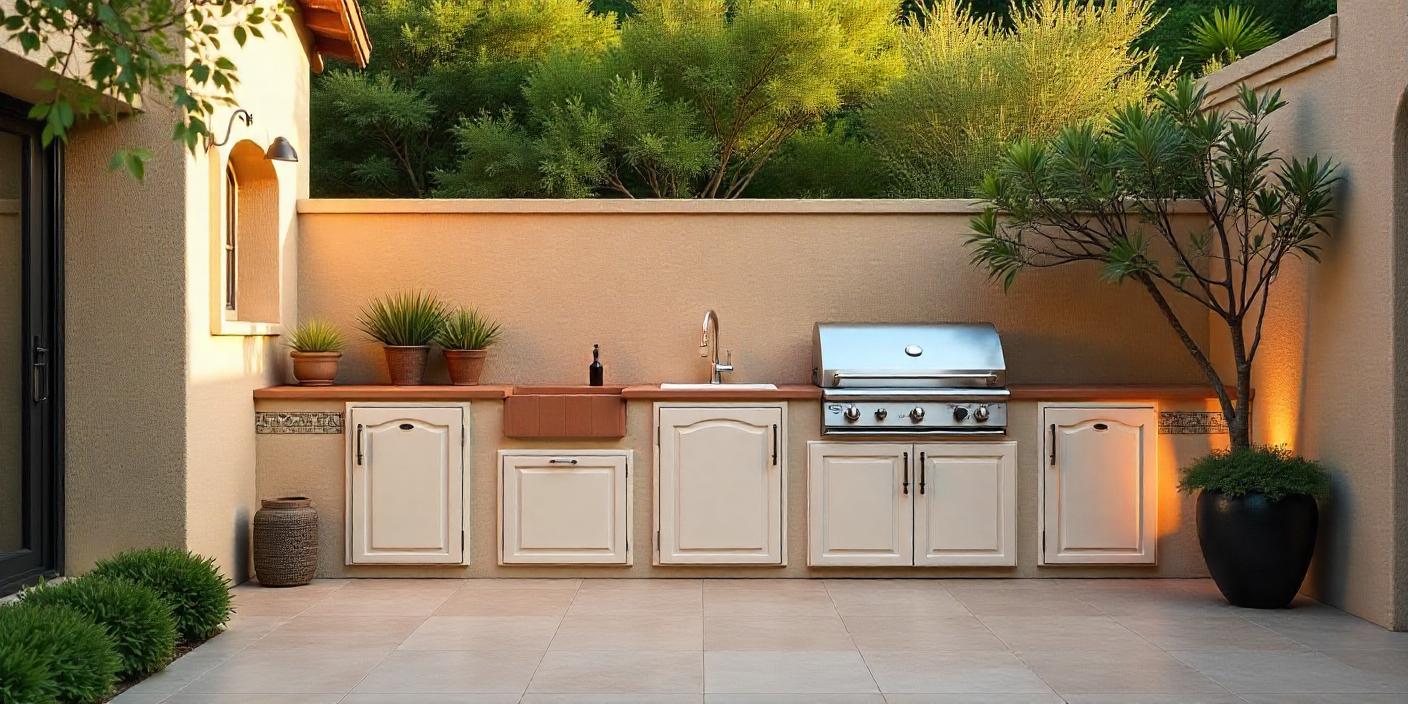When choosing materials for kitchen cabinets, plywood has emerged as a popular and reliable option. It stands out due to its versatility, strength, and cost-effectiveness.
By layering thin sheets of wood veneer, known as plies, at alternating angles, plywood is able to resist warping and cracking, providing a durable base for kitchen cabinetry. Its all-around performance makes it suitable for various designs, from modern minimalist to traditional styles, ensuring it complements the aesthetic of any kitchen space.

Plywood kitchen cabinets offer homeowners the flexibility to customize finishings, from laminates to wood veneers, allowing for an array of textures and colors. This makes it easier to match the cabinets to the existing decor or to achieve a specific look.
Additionally, the ease with which plywood can be handled and installed makes it a practical choice for both professionals and DIY enthusiasts. This adaptability has a significant impact on the installation and assembly processes.
Key Takeaways
- Plywood offers durability and versatility for kitchen cabinets.
- Customize plywood cabinets with a variety of finishes.
- Installation of plywood cabinets is practical for various skill levels.
Understanding Plywood for Kitchen Cabinets
Before we dive into the details, let's understand that plywood is a durable and versatile material ideal for kitchen cabinets, available in several types and grades to suit various needs and preferences.
Types of Plywood
Hardwood Plywood: Typically, hardwood plywood is made from angiosperm trees and is known for its strength and smooth finish. Ideal for visible cabinet surfaces, it presents a fine appearance that takes well to stains and paints.
Softwood Plywood: On the other hand, softwood plywood is derived from gymnosperm trees and is generally used for structural applications where aesthetic isn't top priority. Its softer surface is functional but less ideal for areas prone to wear.
Marine Plywood: Although not commonly used for typical kitchen cabinetry, marine plywood is exceptionally resistant to moisture, thanks to its waterproof adhesives. It's an over-engineered option for areas with high humidity levels.
Plywood Grades
Grades of plywood denote the quality and appearance of the plywood sheets and are paramount when selecting cabinet-grade plywood. Here, we will focus on the two primary faces of plywood:
- “A” Grade: An “A” grade indicates a very smooth and clean surface that is free from knots, patches, or imperfections. It's an excellent choice for cabinet doors or drawers with a natural finish.
- “B” Grade: This grade might have some minor flaws like small knots or slight discoloration. “B” grade is suitable for the interior sections or secondary areas of your cabinetry.
| Grade | Description |
|---|---|
| A | Immaculate with minimal imperfections, perfect for exposed surfaces |
| B | Minor visible flaws are permissible; fit for internal structures |
Keep in mind, the backside of plywood, often concealed within the cabinet structure, typically has a lower grade, balancing cost without compromising structural integrity.
Designing with Plywood
When embarking on creating plywood kitchen cabinets, we need to consider both functionality and aesthetics to ensure the design meets our needs while offering visual appeal. Let's dive into the specifics surrounding cabinet design considerations and how plywood can enhance the aesthetic appeal of our kitchen.
Cabinet Design Considerations
When designing plywood cabinets, we must choose the appropriate plywood grade. For areas that will be visible, such as doors and decorative veneers, opting for a higher-grade plywood with a fine finish is crucial.
Conversely, for structural parts like drawer sides, we can utilize a lower grade but still ensure durability.
- Grain Direction: It's important to align the grain direction vertically for tall cabinets and horizontally for base cabinets. This method not only gives a consistent look but also adds to the structural integrity of the cabinets.
- Thickness: The thickness of plywood is another integral aspect that affects both the aesthetic and the functionality of the cabinetry. Choosing the right thickness means balancing the need for sturdiness with the ease of installation and use.
Aesthetic Appeal
Plywood provides a unique and natural look that can bring warmth and character to our kitchen space. The versatility of plywood allows us to apply various finishes that can either highlight its natural beauty or align with our color scheme.
- Natural Wood Finish: Emphasizing the plywood's natural grain creates an organic, minimalistic atmosphere.
- Painted or Laminated: For a more customized appearance, painting or laminating plywood doors and visible surfaces gives us the freedom to match any desired style and decor.
Construction and Building Techniques
When constructing plywood kitchen cabinets, our focus is on stability and precision. We utilize cabinet-grade plywood for its durability and quality finish. With woods such as birch or oak, we craft cabinets that are not only sturdy but also aesthetically pleasing.
Creating the Cabinet Carcass
We start by building a strong foundation—the carcass. It's essential to use cabinet-grade plywood for the sides, base, and back. We precisely cut each piece to ensure a snug fit and a square frame. Here's a step-by-step process:
- Measure and cut the plywood to create the sides, bottom, and top.
- Assemble using glue and screws for enhanced durability.
- Ensure the carcass is perfectly square to prevent issues with door alignment later.
For the drawer sides, we often opt for thinner plywood to minimize bulk and weight, while ensuring it can withstand regular use.
Attaching Doors and Drawers
After the carcass is assembled, we focus on attaching doors and drawers:
- Doors: Full overlay doors are affixed with concealed hinges, maintaining a clean look.
- Drawers: We mount the drawer slides with care, ensuring seamless movement.
We maintain a precise 1/4″ gap between doors and drawers for a professional, finished appearance. Each door and drawer is carefully measured and installed, considering the unique wood grain patterns, especially when using oak or birch.
Durability and Maintenance
Resistance to Damage
Plywood is inherently resilient due to its cross-laminated structure, which provides it with a high strength-to-weight ratio. This makes our plywood kitchen cabinets less prone to warping, cracking, and splitting, reinforcing their durability against daily kitchen challenges.
Moreover, plywood's sturdy construction means that it holds screws and fasteners more effectively, which is critical for maintaining the structural integrity of the cabinets over time.
The resilience of plywood also extends to a good resistance against scratches and dents, although no material is entirely impervious to damage.
Cleaning and Upkeep
In this section, we explore the robustness of plywood as a material for kitchen cabinets, focusing on its resistance to damage and the ease of maintenance.
Resistance to Damage
Plywood is inherently resilient due to its cross-laminated structure, which provides it with a high strength-to-weight ratio. This makes our plywood kitchen cabinets less prone to warping, cracking, and splitting, reinforcing their durability against daily kitchen challenges.
Moreover, plywood's sturdy construction means that it holds screws and fasteners more effectively, which is critical for maintaining the structural integrity of the cabinets over time.
The resilience of plywood also extends to a good resistance against scratches and dents, although no material is entirely impervious to damage.
Cleaning and Upkeep
For routine maintenance, a simple wipe down with a damp cloth can keep the cabinet surfaces clean and hygienic. For more stubborn stains or grease, a mild detergent solution can be used without harming the wood.
It's crucial to avoid abrasive cleaners which can damage the finish of your cabinets. To maintain their appearance and durability, we recommend occasional checks on the hardware and fastenings to ensure everything remains tight and functional.
Finishing Touches and Materials
When we approach finishing plywood kitchen cabinets, we focus on aesthetics and longevity. The correct finish can dramatically enhance visual appeal and protect cabinetry from wear and tear.
Choice of Finishes
For our plywood cabinets, we have a variety of finishing options that cater to different looks and protection needs.
Paint offers a uniform color and can be custom tinted to match any palette. Meanwhile, stain penetrates the wood to accentuate the plywood's natural grain. Both require thorough preparation to ensure an even application, as mentioned in Painting Plywood Kitchen Cabinets, such as sanding and priming.
- Veneer: A thin layer of real wood applied to the surface for a premium finish.
- Melamine: A resin-saturated paper finish, durable and budget-friendly.
- Edge Banding: Essential for covering the raw edges of plywood to give a neat appearance.
Hardware Selection
The hardware we choose provides function and style. From hinges to handles, the selections are deliberate to complement the finish and design of our plywood kitchen cabinets.
- Hinges: We opt for concealed hinges for their sleek appearance and functionality.
- Handles and Knobs: Choices range from stainless steel to brushed nickel, providing both durability and design versatility.
Installation and Assembly
Before we embark on the installation and assembly of plywood kitchen cabinets, it's important to understand that precision and care are crucial.
We'll detail the necessary steps in measuring and cutting, followed by the assembly process to ensure our DIY cabinets meet both our size requirements and our aesthetic expectations.
Measuring and Cutting
To start, we need to accurately measure the space where our cabinets will be installed using a tape measure.
It's essential that we account for any unique dimensions, as our cabinets need to fit perfectly in the allocated space.
We carefully mark the plywood, keeping in mind the final size of the cabinets, then proceed with cutting it using appropriate tools such as a saw. While cutting, we always verify our measurements to avoid any costly mistakes.
- Tools and Materials Needed:
- Tape measure
- Plywood sheets
- Saw
- Sandpaper
- Pencil
- Measure the height, width, and depth of the cabinet space.
- Transfer these measurements onto the plywood.
- Cut the plywood to size, maintaining straight lines.
Assembly Process
During the assembly process, we'll lay out all cut pieces in order of assembly.
Using a drill, we create pilot holes to ensure that the screws fit perfectly, avoiding any splitting of the wood.
Once the frames and panels are in place, we reinforce the structure to maintain durability.
It's vital to double-check the alignment of everything before securing it permanently.
- Steps for Assembly:
- Lay out all the parts according to the assembly plan.
- Drill pilot holes to avoid wood splitting.
- Secure the framework with screws.
- Install the cabinet doors and hardware.
Environmental Considerations

When we consider plywood kitchen cabinets from an environmental perspective, the focus lies on eco-friendly practices during manufacturing and the sustainability of materials used. It's crucial that we pay close attention to these aspects to minimize our ecological footprint.
Eco-friendly Practices
In our production of plywood kitchen cabinets, we prioritize the use of formaldehyde-free adhesives. This ensures that the bonding process is safer for the environment and reduces the emission of volatile organic compounds.
Additionally, we employ manufacturing techniques that aim to reduce waste and energy consumption. By doing so, we maintain our commitment to environmentally friendly practices.
Material Sustainability
The material choices we make reflect our dedication to sustainability.
We opt for plywood that is sourced from sustainable forests. This is a pivotal aspect in conserving biodiversity and ensuring that our resources are renewable.
To support this, our plywood providers are often certified by recognized organizations that guarantee the wood comes from responsibly managed forests.
For instance, plywood with formaldehyde-free glues and sourced from sustainable forests aligns with our environmental goals.
Furthermore, the inherent strength and longevity of plywood mean that kitchen cabinets made from this material have a prolonged life. This reduces the need for frequent replacements and, therefore, the demand for raw materials, underscoring the sustainable nature of plywood.
Cost Analysis

In this section, we'll evaluate the financial implications of selecting plywood for your kitchen cabinetry. We'll compare plywood to other common materials and assess the long-term value this choice may offer to your home.
Price Comparison
Plywood Kitchen Cabinets often present a more budget-friendly option compared to solid wood. Prices fluctuate based on quality and thickness, but to give a specific idea, one can expect cabinets for a standard-sized kitchen to range between $7,500 and $10,000.
In contrast, Particleboard or MDF (Medium Density Fiberboard) choices might initially lower the cost, but they don't typically match the durability of plywood.
| Material | Initial Cost Estimate |
|---|---|
| Plywood | $7,500 – $10,000 |
| Particleboard | Lower than plywood |
| MDF | Comparable or lower than plywood |
| Solid Wood | Higher than plywood |
Long-Term Value
Opting for plywood kitchen cabinets can be a cost-effective decision in the long haul due to their sturdiness and resistance to wear. One isn't just investing in aesthetics but also in resilience.
Plywood resists warping and damage better than particleboard and MDF, leading to fewer replacements or repairs over time.
When considering solid wood, it's true that it may offer greater longevity, however, the initial investment is substantially higher, and it may not always justify the cost difference.
Frequently Asked Questions
In this section, we'll address some of the common inquiries about plywood kitchen cabinets, focusing on their benefits, costs, design versatility, and comparison with other materials.
What are the advantages of using plywood for kitchen cabinets?
Plywood is renowned for its durability and resistance to moisture, making it an excellent choice for kitchen cabinets. Its layered construction minimizes expansion and contraction, which is pivotal in environments subject to temperature and humidity changes.
How do plywood kitchen cabinets compare in cost to other materials?
The cost of plywood kitchen cabinets can be moderate to high depending on the plywood grade used. Although they might be more expensive than MDF or particle board options, they often provide better longevity and strength, potentially offering savings in the long run.
What design options are available for plywood kitchen cabinets?
Plywood offers significant design flexibility, allowing for a variety of finishes and styles, including contemporary and traditional. Its ability to hold screws and hardware well means that it can support a wide range of designs and decorative elements.
How do plywood and MDF kitchen cabinets differ in durability and quality?
Plywood tends to be stronger and more durable than MDF, as it resists splitting and can hold screws tightly. While MDF might offer a smoother surface for paint, plywood is generally preferred for its structural integrity and ability to withstand heavier loads.
Can plywood kitchen cabinets be customized to fit modern kitchen styles?
Absolutely, plywood is a versatile material that we can easily adapt to suit modern kitchen designs. It accommodates all sorts of customizations, from sizes and shapes to finishes and hardware, aligning with contemporary aesthetics.
What are the considerations when choosing between melamine and plywood for kitchen cabinetry?
When choosing between melamine and plywood, consider that melamine is typically more cost-effective. It also offers a variety of color and pattern options. However, plywood is superior in strength and durability, making it a better choice for long-term use in kitchen cabinetry.





